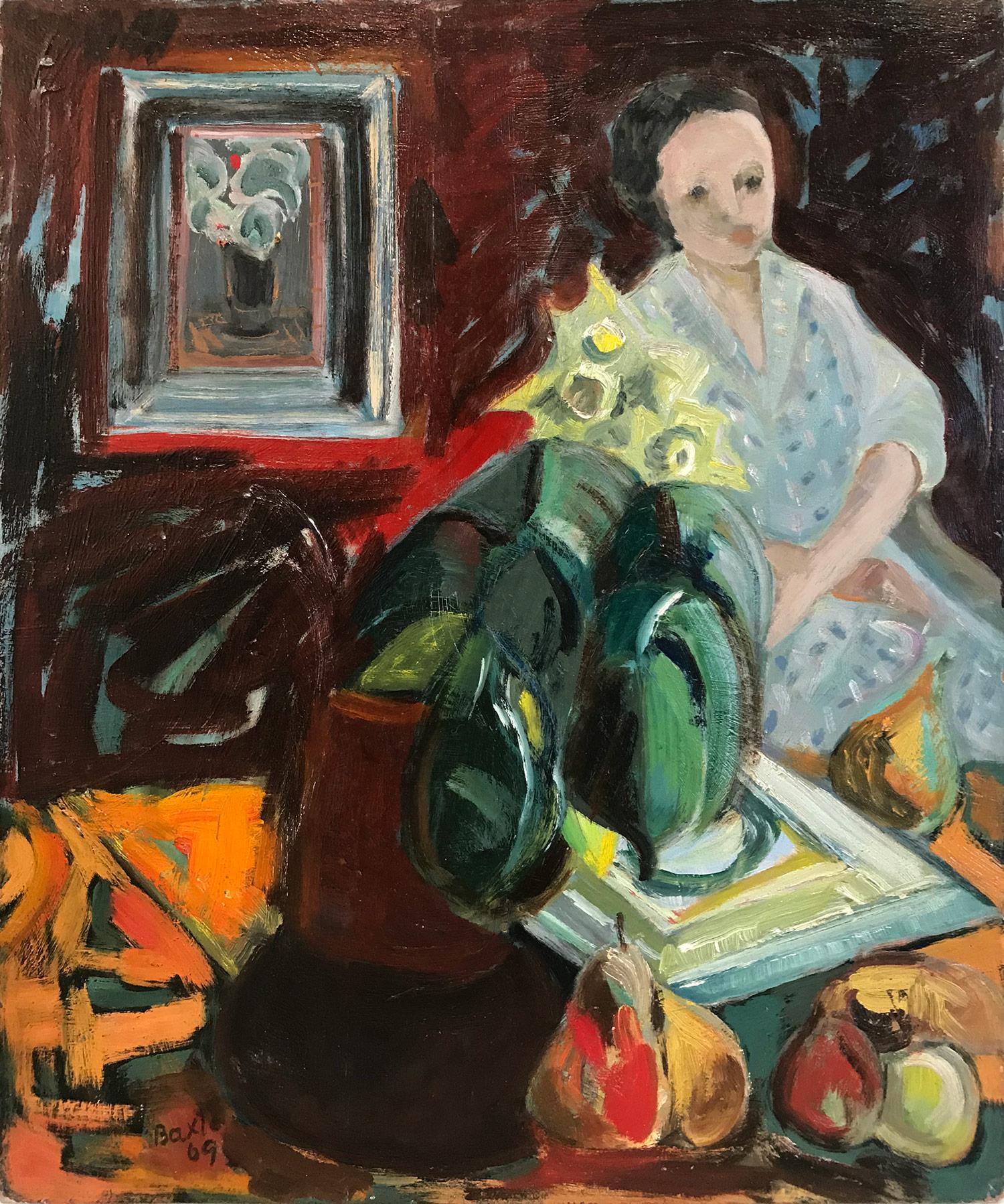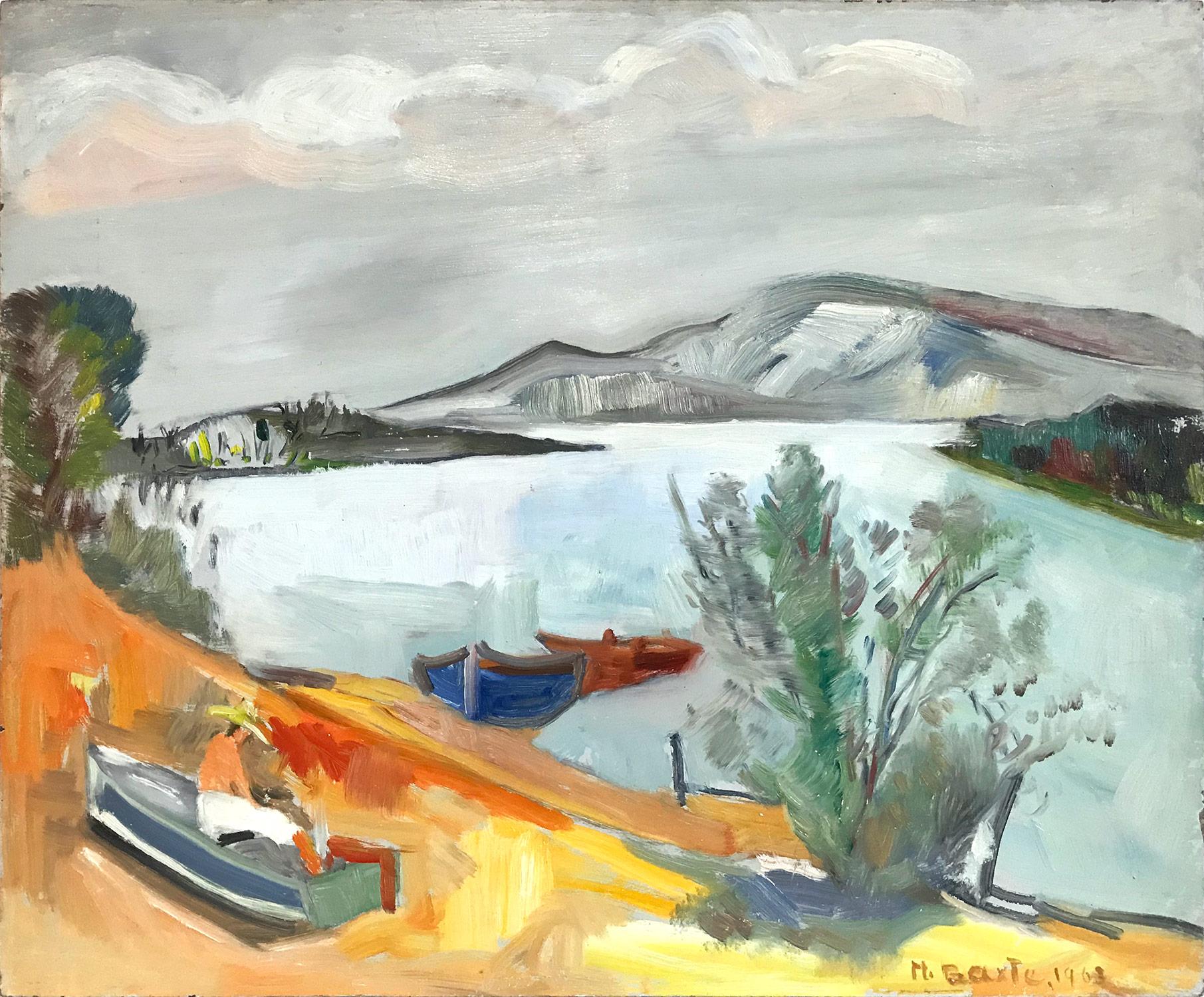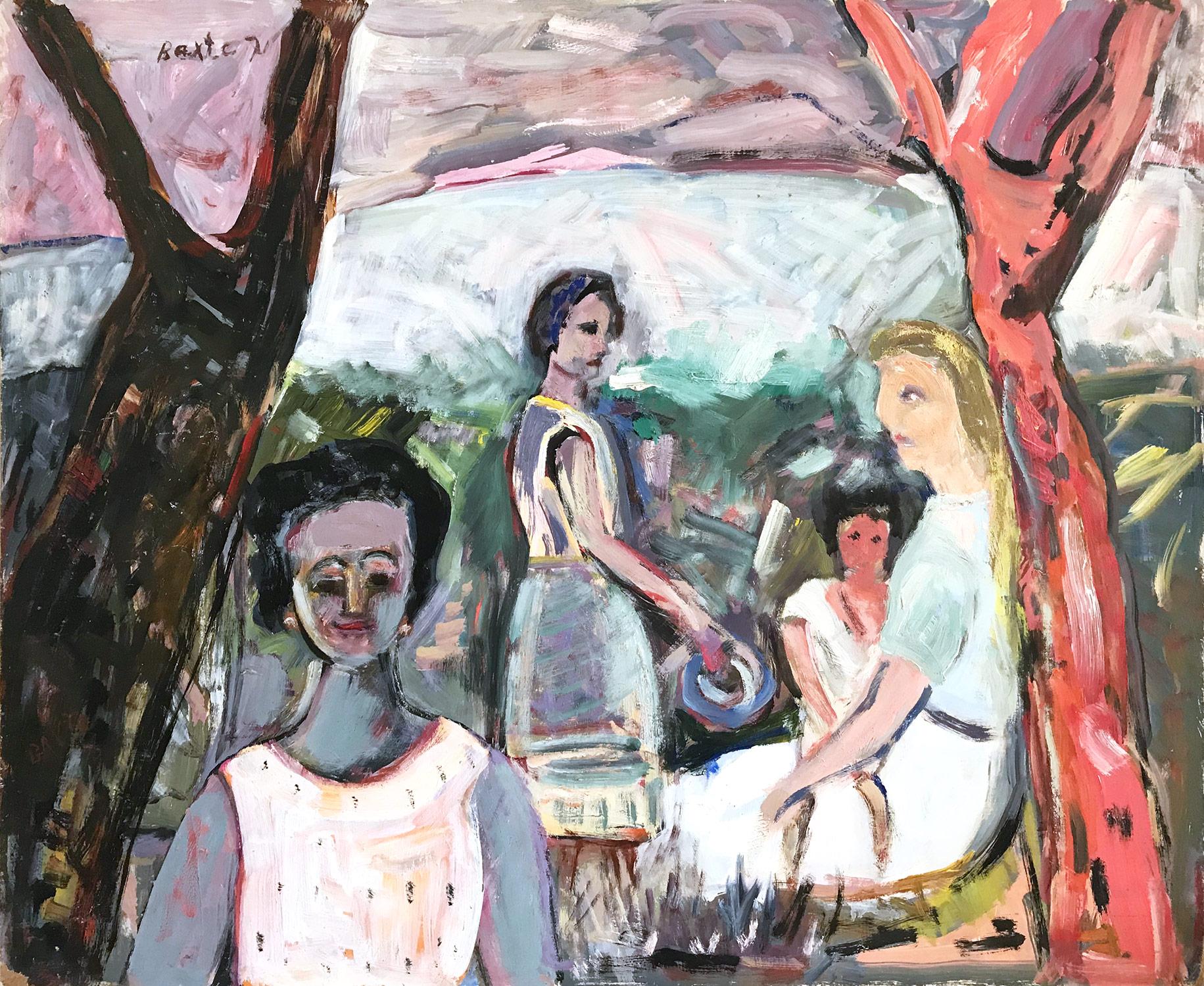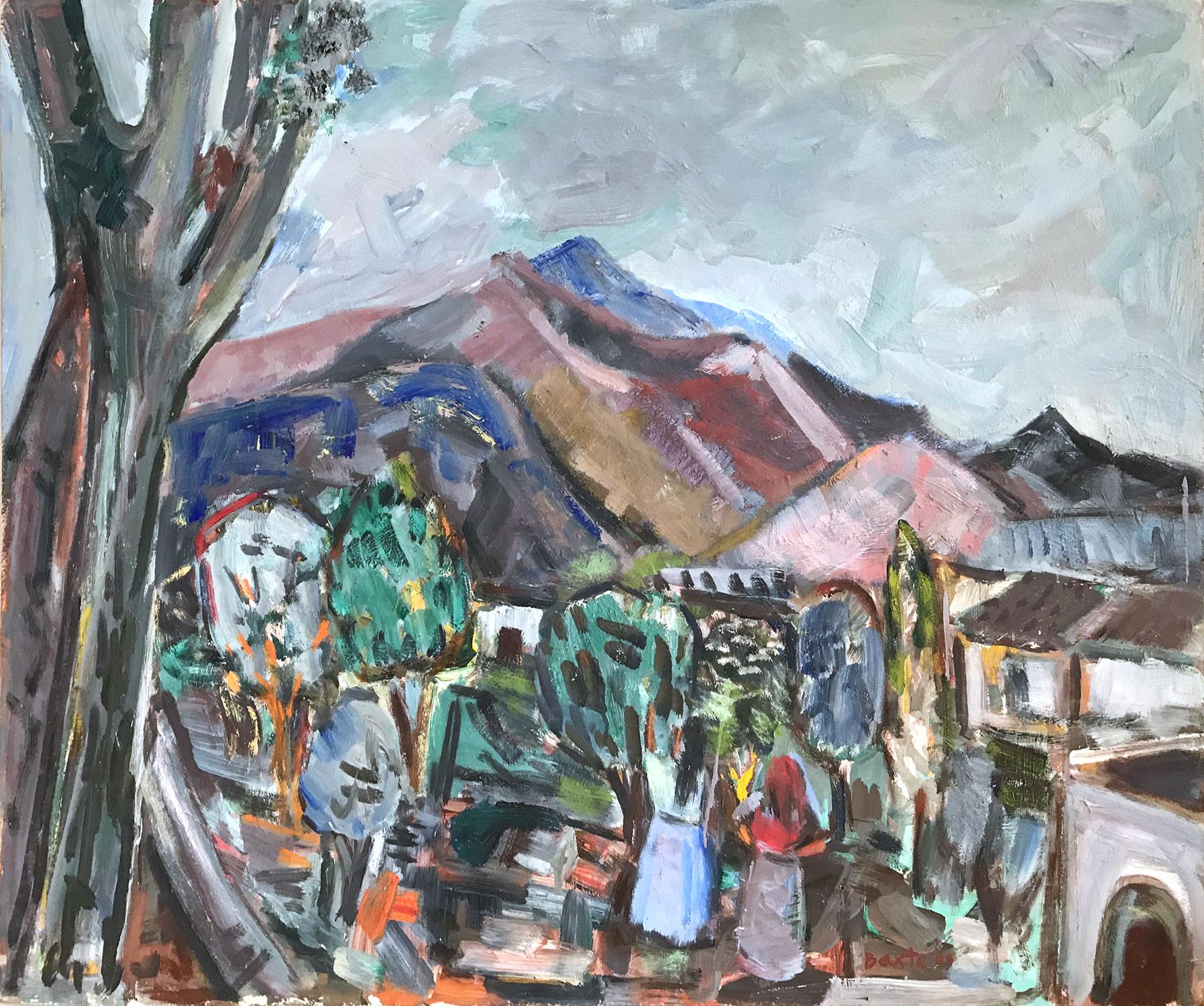Items Similar to 'Young Court Jester Holding a Puppet', Commedia dellArte, Post Impressionist
Want more images or videos?
Request additional images or videos from the seller
1 of 11
M. Dietrich'Young Court Jester Holding a Puppet', Commedia dellArte, Post Impressionist 1963
1963
About the Item
Signed lower right, 'M. Dietrich' (German-American, 20th century) and dated 1963.
A powerful, character-driven portrait of the young man, shown gazing directly towards the viewer. wearing white-face makeup and traditional costume and occupying a background of scumbled ruby and forest-green. An unusually fine study showing accomplished, bravura brushwork and a high degree of psychological penetration.
- Creator:M. Dietrich
- Creation Year:1963
- Dimensions:Height: 30 in (76.2 cm)Width: 23.75 in (60.33 cm)Depth: 0.13 in (3.31 mm)
- Medium:
- Movement & Style:
- Period:
- Condition:minor losses, minor restoration, minor corner bumping; unframed; shows well.
- Gallery Location:Santa Cruz, CA
- Reference Number:1stDibs: LU34410973662
About the Seller
5.0
Platinum Seller
These expertly vetted sellers are 1stDibs' most experienced sellers and are rated highest by our customers.
Established in 1982
1stDibs seller since 2013
629 sales on 1stDibs
Typical response time: <1 hour
- ShippingRetrieving quote...Ships From: Santa Cruz, CA
- Return PolicyA return for this item may be initiated within 3 days of delivery.
More From This SellerView All
- 'Woman Sleeping', Large Modernist Figural Oil, Buenos Aires, Argentina, PortlandBy Julio LavallenLocated in Santa Cruz, CASigned lower left, 'Lavallen', dated 1987 and titled verso 'Mujer Dormida' (Woman Sleeping). A large figural oil painting of a young woman shown reclining on a sofa. Julio Lavallen...Category
1980s Expressionist Figurative Paintings
MaterialsCanvas, Oil
- 'Carnival Figures', New York Exhibited Oil, Mid-century Woman Artist, TheaterBy Dorothy EbensteinLocated in Santa Cruz, CASigned lower center, 'Ebenstein' titled verso, 'Seduction' and painted circa 1966. Accompanied by 1966 exhibition label from Barzansky Galleries, New York. A substantial, Expression...Category
1960s Expressionist Figurative Paintings
MaterialsCanvas, Oil
- 'Still Life with Blue Jug', Contemporary California Expressionist artistBy Anthony McNaughtLocated in Santa Cruz, CAInitialed lower right, 'AEM'; for Anthony Eustace McNaught (American, born 1952) additionally signed verso, 'Anthony McNaught', titled 'Still Life with Blue Jug', and dated 2019. This Post-Impressionist and Expressionist artist studied at the Esalen Institute with Erin Gafill...Category
2010s Expressionist Figurative Paintings
MaterialsOil, Canvas
- 'Chariot', San Francisco Bay Area Abstraction, Mid-Century, Maxwell GalleryLocated in Santa Cruz, CASigned lower left, 'Ide' for Tom Ide (Canadian-American, 1919-1996) and dated 1965. Ide first studied at the Art Institute of Chicago (1951-1955) before movin...Category
1960s Expressionist Abstract Paintings
MaterialsCanvas, Oil
- 'Words to the Wise', African American Memento Mori, Skeletons, Bay Area, BlackLocated in Santa Cruz, CASigned on palette, lower right, 'John Diallo Jones' (American, 20th century) and dated 1992. A dramatic figural oil showing the artist flanked by two whispering skeletons, one of wh...Category
1970s Expressionist Figurative Paintings
MaterialsBoard, Oil
- 'Go, Igor, Go!', 1960's Night Club Go-Go Dancers, Large Post-Impressionist OilLocated in Santa Cruz, CASigned lower right, 'Phillips' for Dick Phillips (American, 20th century) and painted circa 1965. Additionally signed, verso, on stretcher bar, 'Dick Ric...Category
1980s Expressionist Figurative Paintings
MaterialsCanvas, Oil
You May Also Like
- Devil: No Horns, Burning in Hell, African American Harlem RenaissanceLocated in Miami, FLIn a 1971 interview with Ebony Magazine, Alvin Hollinsworth commented on his African Jesus Christ painting, "I have always felt that Christ was a Blac...Category
1970s Expressionist Figurative Paintings
MaterialsMasonite, Oil
- "Landscape Scene of Mexican Villagers" Expressionistic Oil Painting on MasoniteBy Michael BaxteLocated in New York, NYA strong modernist oil painting depicted in 1971 by Russian painter Michael Baxte. Mostly known for his abstracted figures on canvas or street scenes, this piece is a wonderful representation of his landscape paintings, with expressive use of color, shape, and form. Later in his career, Baxte explores Expressionism, infusing both European and North American stylistic trends. This piece is from later in his career, but we can feel this underlying style throughout. Art measures 18 x 21.75 inches Michael Posner Baxte was born in 1890 in the small town of Staroselje Belarus, Russia. For the first half of the 19th century it was a center of the Chabad movement of Hasidic Jews, but this group was gone by the middle of the 19th century. By the time the Baxte family immigrated to the United States at the beginning of the 20th century, the Jewish population numbered only on the hundreds. The native language of the Baxte family was Yiddish. It is likely that the death of Michael Baxte’s father triggered the family’s immigration. Three older brothers arrived in New York between 1903 and 1905. Michael and his mother, Rebecca, arrived in 1907. By 1910 Michael, his mother, and brother, Joseph, were living in New Orleans and may have spent some time on a Louisiana plantation. Around 1912, Michael Baxte returned to Europe to study the violin. In 1914 he, his mother, and Joseph moved to New York City. Meanwhile, in Algeria, a talented young woman painter, Violette Mege, was making history. Since for the first time, a woman won the prestigious Beaux Art competition in Algeria. At first, the awards committee denied her the prize but, with French government intervention, Mege eventually prevailed. She won again 3 years later and, in 1916, used the scholarship to visit the United States of America. When Violette came to New York, she met Baxte, who was, by then, an accomplished violinist, teacher, and composer. Baxte’s compositions were performed at the Tokyo Imperial Theater, and in 1922 he was listed in the American Jewish Yearbook as one of the prominent members of the American Jewish community. As a music teacher he encouraged individual expression. Baxte stated, “No pupil should ever be forced into imitation of the teacher. Art is a personal experience, and the teacher’s truest aim must be to awaken this light of personality through the patient light of science.” By 1920 Michael Baxte and Violette Mege were living together in Manhattan. Although they claimed to be living as husband and wife, it seems that their marriage did not become official until 1928. On their “unofficial” honeymoon around 1917, in Algiers, Baxte confided to her his ambition to paint. There and later in New Mexico where the wonderful steeped sunlight approximates the coloring of Algiers, she taught him his heart’s desire. He never had any other teacher. She never had any other pupil. For ten years she devoted all her time, energy, and ambition to teaching, encouraging, inspiring him. Then in 1928, their mutual strivings were rewarded, as his works were being chosen as one of the two winners in the Dudensing National Competition for American Painters. Out of 150 artists from across the country participated in the Dudensing, and Michael Posner Baxte and, Robert Fawcett, were the winners. In his 1924 naturalization application, he indicated that he was sometimes known as “Michael Posner Baxte.” One of the witnesses to his application was Bernard Karfiol, a Jewish American artist. That’s when Michael may...Category
1960s Expressionist Landscape Paintings
MaterialsMasonite, Oil
- "Interior Scene with Figure" Expressionistic Style Oil Painting on MasoniteBy Michael BaxteLocated in New York, NYA strong modernist oil painting depicted in 1969 by Russian painter Michael Baxte. Mostly known for his abstracted figures on canvas or street scenes, this piece is a wonderful representation of his bold still life paintings, with expressive use of color, shape, and form. Later in his career, Baxte explores Expressionism, infusing both European and North American stylistic trends. This piece is from later in his career, but we can feel this underlying style throughout. Art measures 21.75 x 18 inches Michael Posner Baxte was born in 1890 in the small town of Staroselje Belarus, Russia. For the first half of the 19th century it was a center of the Chabad movement of Hasidic Jews, but this group was gone by the middle of the 19th century. By the time the Baxte family immigrated to the United States at the beginning of the 20th century, the Jewish population numbered only on the hundreds. The native language of the Baxte family was Yiddish. It is likely that the death of Michael Baxte’s father triggered the family’s immigration. Three older brothers arrived in New York between 1903 and 1905. Michael and his mother, Rebecca, arrived in 1907. By 1910 Michael, his mother, and brother, Joseph, were living in New Orleans and may have spent some time on a Louisiana plantation. Around 1912, Michael Baxte returned to Europe to study the violin. In 1914 he, his mother, and Joseph moved to New York City. Meanwhile, in Algeria, a talented young woman painter, Violette Mege, was making history. Since for the first time, a woman won the prestigious Beaux Art competition in Algeria. At first, the awards committee denied her the prize but, with French government intervention, Mege eventually prevailed. She won again 3 years later and, in 1916, used the scholarship to visit the United States of America. When Violette came to New York, she met Baxte, who was, by then, an accomplished violinist, teacher, and composer. Baxte’s compositions were performed at the Tokyo Imperial Theater, and in 1922 he was listed in the American Jewish Yearbook as one of the prominent members of the American Jewish community. As a music teacher he encouraged individual expression. Baxte stated, “No pupil should ever be forced into imitation of the teacher. Art is a personal experience, and the teacher’s truest aim must be to awaken this light of personality through the patient light of science.” By 1920 Michael Baxte and Violette Mege were living together in Manhattan. Although they claimed to be living as husband and wife, it seems that their marriage did not become official until 1928. On their “unofficial” honeymoon around 1917, in Algiers, Baxte confided to her his ambition to paint. There and later in New Mexico where the wonderful steeped sunlight approximates the coloring of Algiers, she taught him his heart’s desire. He never had any other teacher. She never had any other pupil. For ten years she devoted all her time, energy, and ambition to teaching, encouraging, inspiring him. Then in 1928, their mutual strivings were rewarded, as his works were being chosen as one of the two winners in the Dudensing National Competition for American Painters. Out of 150 artists from across the country participated in the Dudensing, and Michael Posner Baxte and, Robert Fawcett...Category
1960s Expressionist Interior Paintings
MaterialsMasonite, Oil
- "Landscape Scene of Fisherman by Lake" Expressionistic Oil Painting on MasoniteBy Michael BaxteLocated in New York, NYA strong modernist oil painting depicted in 1963 by Russian painter Michael Baxte. Mostly known for his abstracted figures on canvas or street scenes, this piece is a wonderful representation of his figures in water landscapes with expressive use of color, shape, and form. Later in his career, Baxte explores Expressionism, infusing both European and North American stylistic trends. This piece is from later in his career, but we can feel this underlying style throughout. Art measures 18 x 21.75 inches Michael Posner Baxte was born in 1890 in the small town of Staroselje Belarus, Russia. For the first half of the 19th century it was a center of the Chabad movement of Hasidic Jews, but this group was gone by the middle of the 19th century. By the time the Baxte family immigrated to the United States at the beginning of the 20th century, the Jewish population numbered only on the hundreds. The native language of the Baxte family was Yiddish. It is likely that the death of Michael Baxte’s father triggered the family’s immigration. Three older brothers arrived in New York between 1903 and 1905. Michael and his mother, Rebecca, arrived in 1907. By 1910 Michael, his mother, and brother, Joseph, were living in New Orleans and may have spent some time on a Louisiana plantation. Around 1912, Michael Baxte returned to Europe to study the violin. In 1914 he, his mother, and Joseph moved to New York City. Meanwhile, in Algeria, a talented young woman painter, Violette Mege, was making history. Since for the first time, a woman won the prestigious Beaux Art competition in Algeria. At first, the awards committee denied her the prize but, with French government intervention, Mege eventually prevailed. She won again 3 years later and, in 1916, used the scholarship to visit the United States of America. When Violette came to New York, she met Baxte, who was, by then, an accomplished violinist, teacher, and composer. Baxte’s compositions were performed at the Tokyo Imperial Theater, and in 1922 he was listed in the American Jewish Yearbook as one of the prominent members of the American Jewish community. As a music teacher he encouraged individual expression. Baxte stated, “No pupil should ever be forced into imitation of the teacher. Art is a personal experience, and the teacher’s truest aim must be to awaken this light of personality through the patient light of science.” By 1920 Michael Baxte and Violette Mege were living together in Manhattan. Although they claimed to be living as husband and wife, it seems that their marriage did not become official until 1928. On their “unofficial” honeymoon around 1917, in Algiers, Baxte confided to her his ambition to paint. There and later in New Mexico where the wonderful steeped sunlight approximates the coloring of Algiers, she taught him his heart’s desire. He never had any other teacher. She never had any other pupil. For ten years she devoted all her time, energy, and ambition to teaching, encouraging, inspiring him. Then in 1928, their mutual strivings were rewarded, as his works were being chosen as one of the two winners in the Dudensing National Competition for American Painters. Out of 150 artists from across the country participated in the Dudensing, and Michael Posner Baxte and, Robert Fawcett, were the winners. In his 1924 naturalization application, he indicated that he was sometimes known as “Michael Posner Baxte.” One of the witnesses to his application was Bernard Karfiol, a Jewish American artist. That’s when Michael may...Category
1960s Expressionist Landscape Paintings
MaterialsMasonite, Oil
- "Mexican Outdoor Scene with Figures" Expressionistic Style Oil Painting on BoardBy Michael BaxteLocated in New York, NYA strong modernist oil painting depicted in the Mid Century by Russian painter Michael Baxte. Mostly known for his abstracted figures on canvas or street scenes, this piece is a wond...Category
1960s Expressionist Landscape Paintings
MaterialsOil, Masonite
- "Pescadores" Expressionistic Style Mexican Scene by the Water with FishermenBy Michael BaxteLocated in New York, NYA strong modernist oil painting depicted in the Mid Century by Russian painter Michael Baxte. Mostly known for his abstracted figures on canvas or street scenes, this piece is a wond...Category
1950s Expressionist Landscape Paintings
MaterialsOil, Masonite





